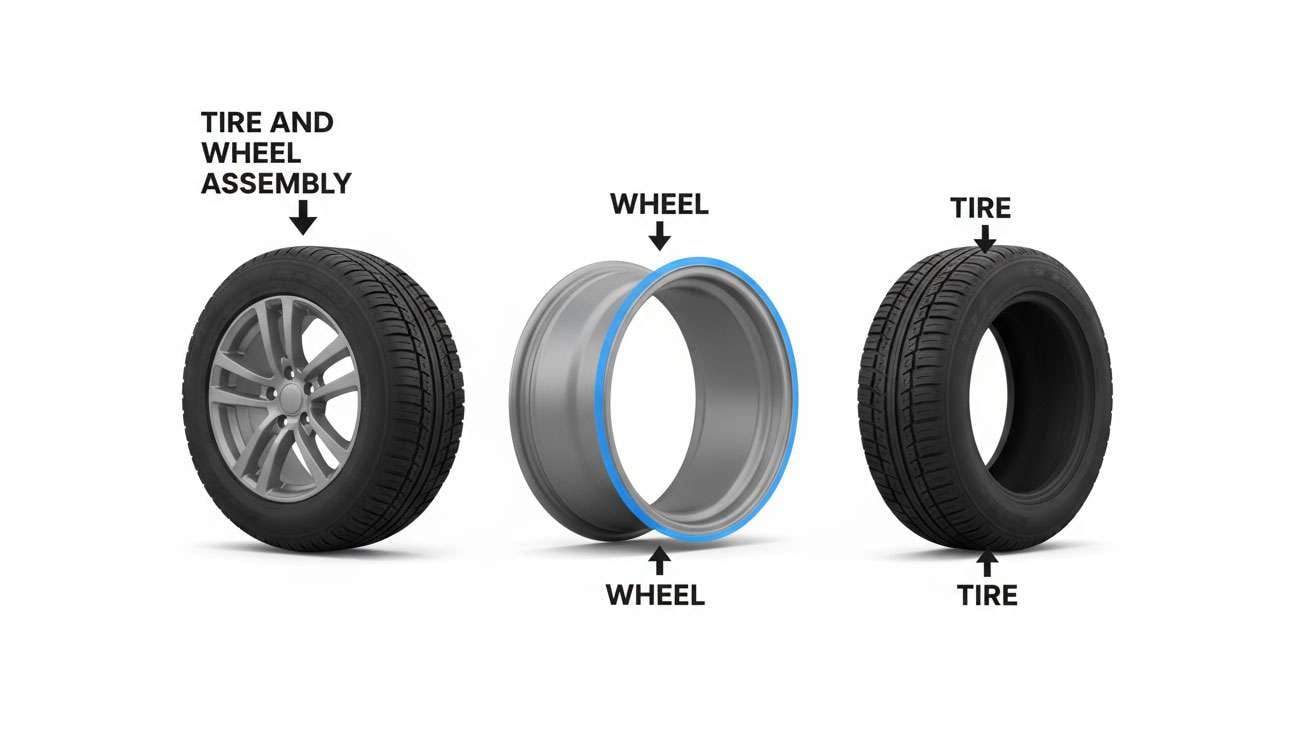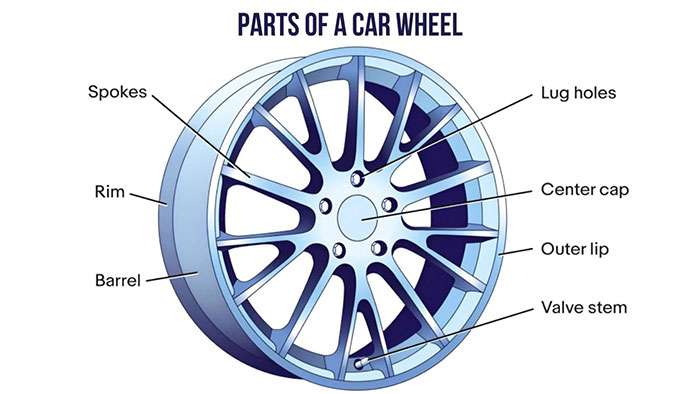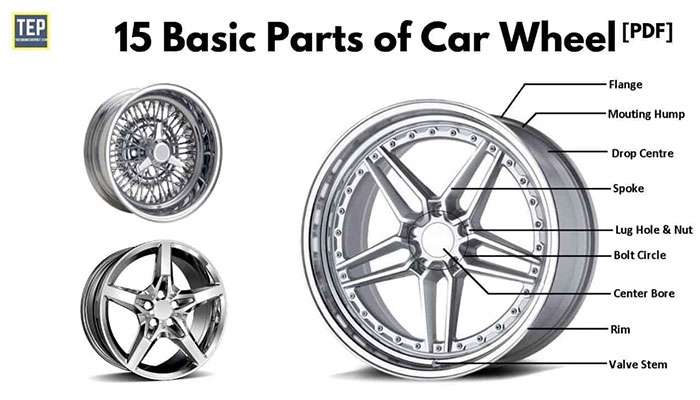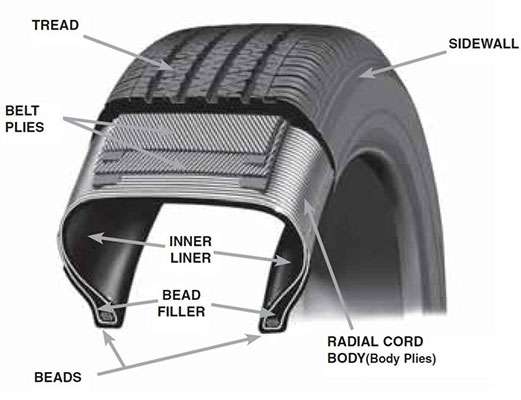
Wheels or tires? This question comes up more often than you might think when vehicle owners talk about the round components that keep their cars rolling. The confusion makes perfect sense, but there's actually a clear distinction between these essential parts.
When you look at your vehicle, the wheel is the complete metal structure that bolts to your vehicle's hub and spins to move you down the road. The tire is the rubber component that wraps around the wheel and touches the pavement. The rim specifically refers to the outer edge of the wheel — that curved outer section that holds the tire securely in place. Most people use "rim" as slang for the entire wheel, but technically it's just one part of the wheel assembly.
We'll break down the differences between wheels, tires, and rims so you know exactly what you're looking at on your vehicle. You'll also learn why these terms get mixed up so often and get clear definitions that help you use the right terminology when talking to mechanics or shopping for replacements.

Image Source: The Engineering Choice
Breaking down each component helps you understand exactly what you're looking at on your vehicle.
The tire is a pneumatic rubber structure that makes direct contact with the road surface. Made from synthetic rubber, natural rubber, fabric, wire, and carbon black, tires deliver traction for acceleration and braking while absorbing road vibrations before they reach your vehicle. The tire features a tread pattern designed for road grip and a body that holds compressed air. The tire bead—built with steel cables wrapped in specially formulated rubber—creates an airtight seal against the wheel.
The wheel represents the complete metal assembly that connects to your vehicle's axle. Typically manufactured from pressed steel or lightweight alloys like aluminum or magnesium, wheels provide the mounting surface for tires. The wheel transfers power from your engine through the drivetrain to create forward motion.
The rim is just one part of the wheel—specifically the outer edge where your tire mounts. Shaped like a "U" when viewed from the side, the rim's main job is maintaining a tight seal with the tire. The rim also serves as protection against road impacts, absorbing the initial shock that passes through the tire.
These three components work together as the complete assembly that keeps your vehicle moving smoothly down the road.

Image Source: The Engineers Post
The differences between tires, wheels, and rims become clear once you understand what each component does for your vehicle.
Tires are exclusively the rubber components that contact the road surface. They provide traction for acceleration and braking, absorb road impacts, and support your vehicle's weight. Tires are designed as replaceable items that wear down over time, and they come in different types for various driving conditions — from all-season to performance to off-road applications.
Wheels are the complete metal assemblies that bolt directly to your vehicle's axle hub. This assembly includes the center disk, spokes, and outer edge working together as one unit. Wheels are typically made from steel or aluminum alloys and last much longer than tires. They serve as the mounting platform that transfers power from your engine through the drivetrain to create movement.
Rims are simply the outer edge of the wheel where the tire mounts. Think of the rim as the foundation that holds your tire securely in place. Most confusion comes from car enthusiasts who use "rims" when they're actually talking about complete aftermarket wheels.
Each component serves a specific purpose that affects your vehicle's performance. Tires determine how well you grip the road and how smoothly you ride. Wheels handle the mechanical connection between your vehicle and the road surface. Rims ensure your tires stay properly seated and maintain their seal.
Understanding these distinctions matters when you're shopping for replacements or upgrades. Each component has different maintenance schedules, replacement costs, and performance considerations that can impact your driving experience.

Image Source: Firestone Complete Auto Care
The mix-up between wheels and tires comes from cultural influences that have shaped how we talk about cars. Automotive aftermarket culture drives most of this confusion, as enthusiasts focused on the flashiest part—the rim—and started calling the whole wheel by just that one piece.
Marketing campaigns made this confusion stick. "Nice rims" became the standard compliment for sharp-looking wheels in car circles. When marketing materials kept using "rim" instead of "wheel," it became part of everyday car talk.
Regional differences add to the mix-up. What people call a "wheel" in one area might be called a "rim" somewhere else. Hip-hop culture, especially in the South, created even more slang like "shoes," "dubs," and "what you're sitting on" for wheels or rims.
The aftermarket industry accidentally encourages this confusion because wheels and tires are among their best-selling products. SEMA Market Research Director Gavin Knapp puts it this way: "We often say the wheel and tire segments are the 'gateway drugs' to our industry". For most enthusiasts, how custom wheels look matters more than getting the terminology right.
Even experienced car enthusiasts keep this confusion going, making "rim" and "wheel" mean the same thing in regular conversation.
Now you know the real difference between wheels, tires, and rims. Each component plays its own important role in keeping your vehicle moving safely down the road. The tire provides crucial traction and shock absorption as the only part that touches the pavement. The wheel is the complete metal assembly that bolts to your axle. The rim is just the outer edge where your tire mounts.
This knowledge comes in handy when you need maintenance or replacements. When someone says "nice rims" about your vehicle, you'll understand they're talking about your wheels as a complete unit. You'll also make better decisions when shopping for upgrades since wheels and tires have different price points, performance characteristics, and replacement schedules.
Car enthusiasts will keep mixing up these terms in casual conversation. That's just how automotive culture works. But knowing the correct terminology helps you communicate clearly with mechanics and tire shops. For those looking to upgrade either component, experts at https://www.performanceplustire.com/ can guide you through selecting the right wheels or tires for your specific vehicle needs.
The next time someone asks whether to call them wheels or tires, you can confidently explain that both terms are correct — they just refer to different parts of the same essential system that keeps you rolling safely down the road.
Understanding the correct terminology for your vehicle's components helps you communicate effectively with mechanics and make informed purchasing decisions.
• Tires are rubber components that contact the road for traction and shock absorption, while wheels are the complete metal assembly connecting to your axle.
• Rims are just the outer edge of the wheel where tires mount—not the entire wheel despite common slang usage in automotive culture.
• Aftermarket culture and marketing popularized using "rims" for entire wheels, creating widespread confusion that persists in casual conversation today.
• Each component serves distinct functions: tires provide grip and cushioning, wheels transfer drivetrain power, and rims secure tires to wheels.
• Knowing these differences matters when shopping for replacements or upgrades, as each has different maintenance schedules, costs, and performance considerations.
While automotive slang will continue blending these terms, understanding the technical distinctions ensures you get exactly what you need when maintaining or upgrading your vehicle's critical rolling components.
Not exactly. The rim is just one part of the wheel - specifically the outer edge where the tire attaches. The wheel refers to the entire metal assembly, including the center disk, spokes, and rim.
The confusion stems from automotive culture and marketing, where "rims" became slang for the entire wheel. This casual usage has become widespread, leading many to use the terms interchangeably even though they're technically different.
A typical wheel consists of the center disk (or spider), spokes, and the rim. The rim is the outer edge that holds the tire, while the center disk attaches to the vehicle's hub. The spokes connect the center to the rim.
Wheels provide the structural support and attachment point to the vehicle, while tires provide the actual contact with the road surface. Together, they form the critical assembly that allows for vehicle movement, with the wheel transferring power from the drivetrain and the tire providing traction and shock absorption.